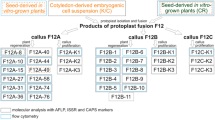Summary
Protoplasts of three Rosa cultivars were fused with each other, with protoplasts of Prunus `Colt' and with protoplasts of Rubus laciniatus, using polyethylene glycol 4000 as a fusogen. Protoplasts of Prunus were incapable of cell division and those of Rosa and Rubus were disabled by treatments with metabolic inhibitors, either iodoacetate (IOA) or rhodamine 6-G (R6G). Parental protoplasts were then fused in combinations that required complementation for their survival. RAPD analysis of 41 fusion-derived cell lines showed that two lines resulting from fusions of Rosa + Rosa and one from a fusion of Rosa + Prunus, contained some DNA markers from both fusion partners. The others contained markers of only one fusion parent. This showed that after protoplast fusion, the heterokaryons did not develop into cell lines with stable hybrid nuclei. Plants regenerated from cell lines derived from Rosa + Prunus and Rosa + Rubus fusions contained DNA markers of only Rosa and their DNA amounts were no greater than that of the Rosa parent. However, they differed morphologically from the Rosa parent to a remarkable degree, possibly because they inherited undetected genes of Prunus or Rubus, or because they were somaclonal variants of the Rosa parent. Alternative strategies for the production of somatic hybrids are discussed.
Similar content being viewed by others
References
Baird, E., S. Cooper-Bland, R. Waugh, M. DeMaine & W. Powell, 1992. Molecular characterisation of inter and intraspecific somatic hybrids of potato using randomly amplified polymorphic DNA (RAPD) markers. Mol Gen Genet 233: 469–475.
Böttcher, U.F., D. Aviv & E. Galun, 1989. Complementation between protoplasts treated with either of two metabolic inhibitors results in somatic hybrid plants. Plant Sci 63: 67–77.
Cheng, A.X., G.M. Xia, D.Y. Zhi & H.M. Chen, 2004. Intermediate fertile Triticum aestivum (plus) Agropyron elongatum somatic hybrids are generated by low doses of UV irradiation. Cell Res 14: 86–91.
Collonnier, C., K. Mulya, I. Fock, I. Mariska, A. Servaes, F. Vedel, S. Siljak-Yakovlev, V. Souvannavong, G. Ducreux & D. Sihachakr, 2001. Source of resistance against Ralstonia solanacearum in fertile somatic hybrids of eggplant (Solanum melongena L.) with Solanum aethiopicum L. Plant Sci 160: 310–131.
Demesure, B., N. Sodzi & R.J. Petit, 1995. A set of universal primers for the amplification of polymorphic non-coding regions of mitochondrial and chloroplast DNA. Mol Ecol 6: 113–118.
Doyle, J.J. & J.L. Doyle, 1987. A rapid DNA isolation procedure for small quantities of fresh leaf tissue. Phytochem Bull 19: 11–15.
Gear, A.R.L., 1974. Rhodamine 6 G, a potent inhibitor of mitochondrial oxidative phosphorylation. J Biol Chem 249: 3628-3637.
Johnson, A.A.T. & R.E. Vellieux, 2001. Somatic hybridization and applications in plant breeding. Plant Breeding Rev 20: 167–225.
Kao, K.N. & M.R. Michayluk, 1975. Nutritional requirements for growth of Vicia hajastana cells and protoplasts at a very low population density in liquid media. Planta 126: 105–110.
Kim, S.W., S.C. Oh, D.S. In & J.R. Liu, 2003. Plant regeneration of rose (Rosa hybrida) from embryogenic cell-derived protoplasts. Plant Cell Tiss Org Cult 73: 15–19.
Li, C., G. Xia, F. Xiang, F. Xiang, C. Zhou & A. Cheng, 2004. Regeneration of asymmetric somatic hybrid plants from the fusion of two types of wheat with Russian wild rye. Plant Cell Rep 23: 461–467.
Marchant, R., M.R. Davey & J.B. Power, 1997. Isolation and culture of mesophyll protoplasts from Rosa hybrida. Plant Cell Tiss. Org Cult 50: 131–134.
Matthews, D., J. Mottley, I. Horan & A.V. Roberts, 1991. A protoplast to plant system in roses. Plant Cell Tiss Org Cult 24: 173–180.
Murashige, T. & F. Skoog, 1962. A revised medium for rapid growth and bio-assays with tobacco tissue cultures. Physiol Plant 15: 473–497.
Polgár, Zs., J. Preiszner, D. Dudits & A. Fehér, 1993. Vigorous growth of fusion products allows highly efficient selection of interspecific potato somatic hybrids: molecular proofs. Plant Cell Rep 12: 399–402.
Power, J.B. & J.V. Chapman, 1985. Isolation, culture and genetic manipulation of plant protoplasts. In: Dixon R.A. (Ed.), Plant cell culture: A practical approach, pp. 37–66. IRL Press, Oxford, Washington DC.
Roberts, A.V. & R. Lewis, 1996. Rose phenotypes: Questions of diversity and development. Acta Hortic 424: 313–319.
Rokka, V.-M., Y.-S. Xu, J. Kankila, A. Kuusela, S. Pulli & E. Pehu, 1994. Identification of somatic hybrids of dihaploid Solanum tuberosum lines and S. brevidens by species specific RAPD patterns and assessment of disease resistance of the hybrids. Euphytica 80: 207–217.
Schenk, R.U. & A.C. Hildebrandt, 1972. Medium and techniques for induction and growth of monocotyledonous and dicotyledonous plant cell cultures. Can J Bot 50: 199–204.
Schum, A., K. Hofmann, N. Ghalib & A. Tawfik, 2001. Factors affecting protoplast isolation and plant regeneration in Rosa spp. Gartenbauwissenschaft 66: 115–122.
Welsh, J. & M. McClelland, 1990. Fingerprinting genomes using PCR with arbitrary primers. Nucleic Acids Res 18: 7213–7218.
Williams, J.G.K., A.R. Kubelik, K.J. Lival, J.A. Rafalski & S.V. Tingey, 1990. DNA polymorphisms amplified by arbitrary primers are useful as genetic markers. Nucleic Acids Res 18: 6531–6535.
Wright, W.E., 1978. The isolation of heterokaryons and hybrids by a selective system using irreversible biochemical inhibitors. Exp Cell Res 112: 395–407.
Xiang, F.N., G.M. Xia & H.M. Chen, 2003. Effect of UV dosage on somatic hybridization between common wheat (Triticum aestivum L.) and Avena sativa L. Plant Sci 164: 697–707.
Yokoya, K., A.V. Roberts, R. Lewis, J. Mottley & P.E. Brandham, 2000. Nuclear DNA amounts in roses. Ann Bot 85: 557–561.
Zhou, A.F., G.M. Xia, H.M. Chen & H. Hu, 2001. Production of somatic hybrid plants between two types of wheat protoplasts and the protoplasts of Haynaldia villosa. Sci Chin Ser C 44: 294–304.
Author information
Authors and Affiliations
Corresponding author
Rights and permissions
About this article
Cite this article
Squirrell, J., Mandegaran, Z., Yokoya, K. et al. Cell lines and plants obtained after protoplast fusions of Rosa+Rosa, Rosa+Prunus and Rosa+Rubus . Euphytica 146, 223–231 (2005). https://doi.org/10.1007/s10681-005-9011-5
Received:
Accepted:
Published:
Issue Date:
DOI: https://doi.org/10.1007/s10681-005-9011-5




